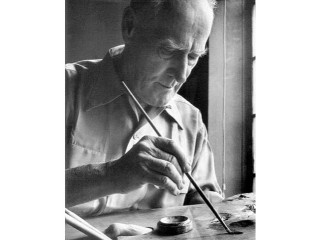
Lyonel Feininger biography
Date of birth : 1871-07-17
Date of death : 1956-01-11
Birthplace : New York City, New York, U.S.
Nationality : American
Category : Arts and Entertainment
Last modified : 2011-11-10
Credited as : painter, illustrator, German Bauhaus
The American painter and illustrator Lyonel Feininger was one of the leading artists of the German Bauhaus.
Lyonel Feininger was born on July 17, 1871, in New York, the son of German musicians who had emigrated to the United States. In 1887 he went to Germany to study music, but he decided on the visual arts and attended the Hamburg School of Arts and Crafts and the Berlin Academy of Arts until 1891. He then went to Paris and studied at the Academie Colarossi until 1893.
Feininger showed an outspoken talent for caricature and became a contributor to the German humorous periodicals Ulk and Fliegende Blatter in Berlin, where he lived from 1894 to 1906. He then returned to Paris and produced drawings for the Chicago Sunday Tribune and the Parisian paper Le Temoin. His caricatures, which were capricious and fantastic, had much in common with Paul Klee's early drawings.
In 1908 Feininger returned to Berlin. On a visit to Paris in 1911 he met Robert Delaunay and became acquainted with cubist painting. It was the constructive-ordering principle dominating cubism that attracted Feininger most and appealed to his personal taste. Cubism and the Section d'Or group had a decisive influence on the formation of his painting. His first cubist paintings date from 1912. His own style was representational and two-dimensional, rendered in a prismatic protocubist manner. Light played a predominant role in his work; the rays of light were used in both the structure and the coloring of the composition.
In 1913 the artists of the Blaue Reiter group invited Feininger to exhibit with them in Berlin's First German Autumn Salon. His friendships with Wassily Kandinsky, Klee, and Alexei von Jawlensky began at this time, and later, in 1924, the four artists founded the Blaue Vier group.
Feininger's personal style was established about 1915. Abstract elements, however, had appeared in his earlier compositions. In 1919 the architect Walter Gropius, the founder of the Bauhaus in Weimar, asked Feininger to teach painting there. Architecture, which was one of Feininger's main themes, came even more into the foreground during his Bauhaus period. The other main theme in the artist's oeuvre (both oils and watercolors) was seascapes with high skies and sailing boats. When the Bauhaus moved to Dessau in 1925, Feininger left as a teacher but remained in contact with this institution until it closed in 1933. He exhibited with the Blaue Vier group from 1933 to 1936.
In 1937 Feininger returned to New York, where he died on Jan. 11, 1956. His late pictures have a pristine classical character. His art, with its emphasis on proportion, transparency, and serenity, is well balanced and harmonious.




















